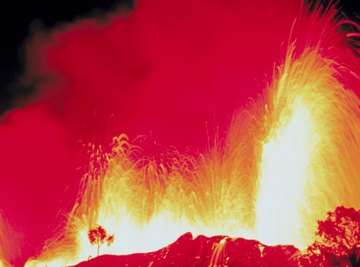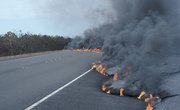
There are two main types of volcanoes: stratovolcanoes and shield volcanoes. Stratovolcanoes, also known as composite volcanoes, are cone-shaped volcanoes caused by highly viscous or sticky magma that explodes and builds up in a peak around the crater. Shield volcanoes have a gentler slope as the magma is more fluid and flows away from the crater. Volcanic eruptions of magma cause a wide diversity of geologic shapes and features to develop, the formation of which helps make each volcano unique. Land changes can also be indicators of an impending volcanic eruption.
Signs of Impending Volcanic Eruptions
Volcanic deformation, or changes to the ground, is a common sign of an impending volcanic eruption. Swelling, cracking or sinking of the ground are all types of volcanic deformation. These changes in the Earth's surface are the result of the underground movement of magma, fluids, gases or the Earths' tectonic plates.
Subtle swelling of the volcano can be caused by the magma inside the volcano rising to the surface. This swelling may only alter the volcano shape by a few inches, or even less. The rising magma and heat also cause changes in the surrounding soil and water chemistry.
The underground movement of hot water, steam or gases may result in noticeable steaming from the ground, the unpredictable opening of new steam or gas vents (called fumaroles) or changes to the physical structure of the ground as it gets pushed up. The chemical composition and abundance or location of fumaroles are also signs of impending volcanic eruptions.
Volcanic Earthquakes
An increase in the frequency and intensity of small earthquakes is another signal that a volcanic eruption may occur. Low-frequency volcanic earthquakes result from the breaking of brittle rocks and cracking of the Earth's surface due to the underground movements of fluid, magma and gases. Ongoing high-amplitude seismic signals are signs of volcanic earthquakes that may signal an eruption.
Volcanic earthquakes tend to be within seven miles of the surface and too small to feel. Seismologists, earth scientists who specialize in studying geological movements, closely monitor volcanic earthquake movements using seismographs.
Volcanic earthquake events usually feature dozens or hundreds of events grouped together, called swarms. Swarms typically occur prior to an eruption, however most swarms don't result in an eruption. This means seismologists must be on high alert during these times and monitor other signs to determine if an eruption is likely.
Additionally, tectonic earthquakes from fault lines may trigger nearby volcanoes to erupt. This only occurs if there is enough eruptive magma waiting within that volcanic system and if there is already significant pressure surrounding the magma. Predicting eruptions is often difficult because of the multitude of factors involved.
Monitoring Volcanic Activity
Volcanologists, scientists who study volcanoes, take ground-based measurements at specific spots which are tracked using geographic positioning software receivers. Scientists measure the tilt of the ground using tiltmeters. The strain or deformation of the ground is measured using strainmeters.
Finally, creepmeters are placed across fault lines to monitor movement. This information, alongside space-based satellite observations, helps volcanologists predict if a volcanic eruption will occur.
Examples of Volcanic Hazards
The products of large volcanic eruptions can reach over 60 miles away from the volcano crater. Supervolcano eruptions, such as Yellowstone in the United States, are powerful enough to impact the global climate.
The largest volcanic eruption in the last 5,000 years was Taupo in New Zealand. Estimated to have occurred around 186 AD, this supervolcano covered New Zealand in 0.39 inches of ash. It is also thought that the red sunsets reported around the same time by the Romans and Chinese were caused by the atmospheric ash from the Taupo eruption.
Volcanic hazards include magma explosions, exposure to toxic gases, lava flows or mudflows called lahars, and falling tephra, or ash debris. The four main volcanic gases are carbon dioxide, sulfur dioxide, hydrogen sulfide and hydrogen halides. In certain concentrations, these gases damage health or cause fatalities in humans, animals and plants.
Hydrogen halides are also highly water-soluble so they can easily infuse into water droplets and cause acid rain or attach to ash particles then poison waterways and drinking water. Other hazards caused by volcanic activity include tsunamis, landslides, debris avalanches and jökulhlaups, an Icelandic word that refers to a rapid release of water from a glacial lake that causes large amounts of flooding.
References
- United States Geological Survey: Monitoring Volcano Seismicity Provides Insight to Volcanic Structure
- Journal of Applied Volcanology: Volcanic Fatalities Database: Analysis of Volcanic Threat With Distance and Victim Classification
- GNS Science: Taupo Volcano
- Nature: A New Date for the Taupo Eruption, New Zealand
- Outside: Yellowstone Volcano
About the Author
Adrianne Elizabeth is a freelance writer and editor. She has a Bachelor of Science in Ecology and Biodiversity, and Marine Biology from Victoria University of Wellington in New Zealand. Driven by her love and fascination with all animals behavior and care, she also gained a Certificate in Captive Wild Animal Management from UNITEC in Auckland, New Zealand, with work experience at Wellington Zoo. Before becoming a freelance writer, Adrianne worked for many years as a Marine Aquaculture Research Technician with Plant & Food Research in New Zealand. Now Adrianne's freelance writing career focuses on helping people achieve happier, healthier lives by using scientifically proven health and wellness techniques. Adrianne is also focused on helping people better understand ecosystem functions, their importance, and how we can each help to look after them.
Photo Credits
Ablestock.com/AbleStock.com/Getty Images
